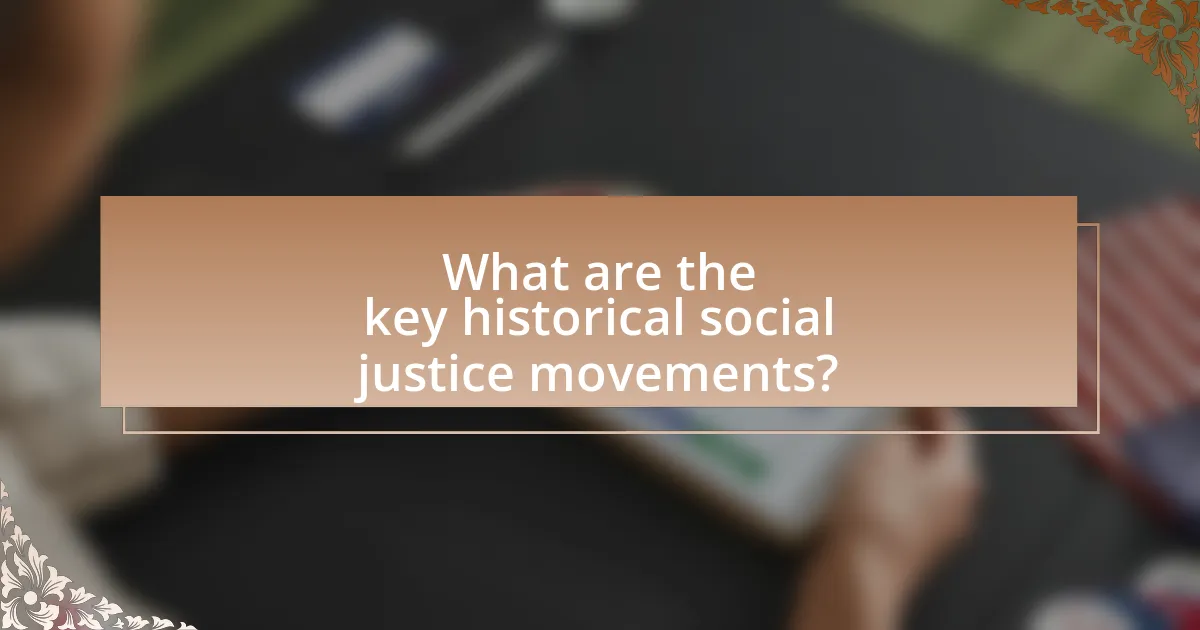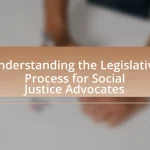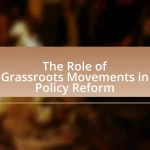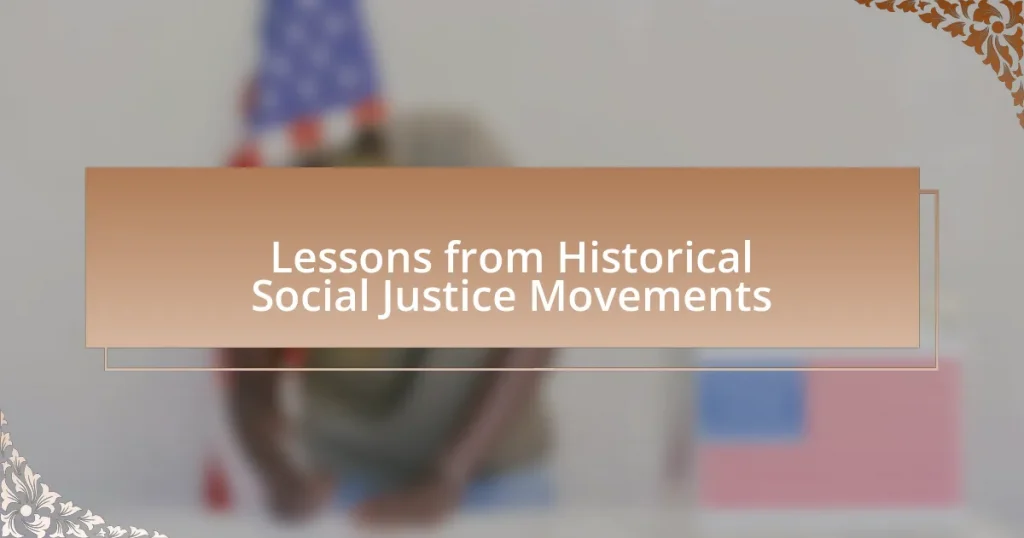The article focuses on the lessons derived from key historical social justice movements, including the Civil Rights Movement, Women’s Suffrage Movement, LGBTQ+ Rights Movement, and the Anti-Apartheid Movement. It examines how these movements emerged in response to specific social, political, and economic contexts, highlighting the factors that contributed to their rise and the evolution of their goals over time. The article also discusses the major achievements and legislative changes resulting from these movements, the challenges they faced, and the strategies that proved effective in achieving social justice. Additionally, it emphasizes the importance of learning from past movements to inform contemporary activism and outlines practical steps individuals can take to support social justice today.

What are the key historical social justice movements?
Key historical social justice movements include the Civil Rights Movement, Women’s Suffrage Movement, LGBTQ+ Rights Movement, and the Anti-Apartheid Movement. The Civil Rights Movement in the United States, particularly from the 1950s to the 1960s, aimed to end racial segregation and discrimination against African Americans, leading to significant legislative changes like the Civil Rights Act of 1964. The Women’s Suffrage Movement, which gained momentum in the late 19th and early 20th centuries, fought for women’s right to vote, culminating in the 19th Amendment in 1920. The LGBTQ+ Rights Movement, particularly prominent since the 1960s, advocates for the rights and acceptance of LGBTQ+ individuals, achieving milestones such as the legalization of same-sex marriage in many countries. The Anti-Apartheid Movement in South Africa sought to dismantle the system of racial segregation and oppression, leading to the end of apartheid in the early 1990s and the election of Nelson Mandela as the first Black president in 1994. Each of these movements has significantly shaped societal norms and legal frameworks regarding equality and justice.
How did these movements emerge in different contexts?
Social justice movements emerged in different contexts due to varying social, political, and economic conditions. For instance, the Civil Rights Movement in the United States arose from systemic racial discrimination and segregation, particularly highlighted by events such as the Jim Crow laws and the 1955 Montgomery Bus Boycott. Similarly, the Women’s Suffrage Movement gained momentum in the early 20th century as women sought equal voting rights, driven by the broader context of industrialization and changing gender roles. In South Africa, the anti-apartheid movement emerged in response to institutionalized racial segregation and oppression, with key events like the Sharpeville Massacre in 1960 galvanizing international support. Each movement was shaped by its unique historical context, reflecting the specific injustices faced by the communities involved.
What social, political, and economic factors contributed to their rise?
Social, political, and economic factors that contributed to the rise of historical social justice movements include widespread inequality, political repression, and economic hardship. Inequality often galvanized marginalized groups to demand rights and representation, as seen in the Civil Rights Movement in the United States, where systemic racism and segregation prompted collective action. Political repression, such as censorship and authoritarian governance, frequently led to organized resistance, exemplified by the anti-apartheid movement in South Africa, which arose in response to oppressive laws and practices. Economic hardship, including unemployment and poverty, served as a catalyst for movements like the labor rights movement, where workers united to fight for fair wages and working conditions during the Great Depression. These factors collectively created an environment ripe for mobilization and activism, leading to significant social change.
How did the goals of these movements evolve over time?
The goals of historical social justice movements evolved from initial demands for basic rights and recognition to broader aspirations for systemic change and equity. For example, the civil rights movement in the United States began with a focus on ending racial segregation and securing voting rights, as evidenced by the Civil Rights Act of 1964 and the Voting Rights Act of 1965. Over time, the movement expanded to address issues such as economic inequality, police brutality, and intersectionality, reflecting a more comprehensive understanding of social justice. Similarly, the women’s suffrage movement initially aimed at securing voting rights for women but later encompassed issues like reproductive rights and gender equality in the workplace, demonstrating a shift towards a more inclusive agenda. This evolution illustrates how social justice movements adapt to changing societal contexts and the needs of their constituents.
What were the major achievements of historical social justice movements?
Major achievements of historical social justice movements include the abolition of slavery, women’s suffrage, and civil rights advancements. The abolition of slavery, marked by the Emancipation Proclamation in 1863 and the 13th Amendment in 1865, ended legal slavery in the United States. Women’s suffrage was achieved with the ratification of the 19th Amendment in 1920, granting women the right to vote. The civil rights movement led to significant legislation, including the Civil Rights Act of 1964 and the Voting Rights Act of 1965, which prohibited discrimination based on race and protected voting rights for African Americans. These movements collectively transformed societal norms and legal frameworks, promoting equality and justice.
Which legislative changes resulted from these movements?
Legislative changes resulting from historical social justice movements include the Civil Rights Act of 1964, which prohibited discrimination based on race, color, religion, sex, or national origin, and the Voting Rights Act of 1965, which aimed to eliminate barriers to voting for African Americans. These acts were direct responses to the civil rights movement, which highlighted systemic inequalities and mobilized public support for reform. Additionally, the Women’s Liberation Movement led to the passage of Title IX in 1972, prohibiting sex-based discrimination in federally funded education programs. These legislative changes reflect the significant impact of social justice movements on U.S. law and policy.
How did these movements influence public opinion and cultural norms?
Social justice movements significantly influenced public opinion and cultural norms by raising awareness of systemic inequalities and advocating for marginalized groups. For instance, the Civil Rights Movement in the United States led to widespread recognition of racial discrimination, resulting in landmark legislation such as the Civil Rights Act of 1964, which prohibited discrimination based on race, color, religion, sex, or national origin. This shift in legal frameworks reflected and reinforced changing societal attitudes towards race and equality, demonstrating how organized activism can reshape cultural perceptions and norms. Additionally, movements like LGBTQ+ rights campaigns have transformed public attitudes towards sexual orientation and gender identity, leading to increased acceptance and legal protections, such as the legalization of same-sex marriage in many countries. These examples illustrate the profound impact that social justice movements have on both public opinion and cultural standards.
What challenges did historical social justice movements face?
Historical social justice movements faced significant challenges, including systemic oppression, lack of resources, and societal resistance. For instance, the Civil Rights Movement in the United States encountered violent backlash from segregationists and law enforcement, exemplified by events such as the Birmingham campaign in 1963, where peaceful protesters were met with police brutality. Additionally, movements often struggled with internal divisions and differing ideologies, as seen in the feminist movement, which grappled with intersectionality and the inclusion of diverse voices. These challenges hindered progress and required persistent advocacy and strategic coalition-building to overcome.
What forms of opposition did these movements encounter?
Social justice movements encountered various forms of opposition, including legal challenges, violent repression, and societal backlash. For instance, the Civil Rights Movement faced significant legal obstacles such as Jim Crow laws, which enforced racial segregation and discrimination. Additionally, activists often experienced violent responses from law enforcement and white supremacist groups, exemplified by events like the Selma to Montgomery marches in 1965, where peaceful protesters were met with brutal force. Furthermore, societal backlash manifested in public opinion against these movements, as seen in the resistance to desegregation efforts in the 1950s and 1960s, where many communities opposed integration. These forms of opposition highlight the significant challenges faced by social justice movements in their pursuit of equality and rights.
How did internal divisions impact their effectiveness?
Internal divisions significantly undermined the effectiveness of historical social justice movements by creating fragmentation and reducing collective action. For instance, during the Civil Rights Movement in the United States, divisions between groups such as the Southern Christian Leadership Conference and the Student Nonviolent Coordinating Committee led to conflicting strategies and priorities, which diluted their overall impact. This fragmentation often resulted in missed opportunities for unified action, weakening their ability to challenge systemic injustices effectively.
How can we learn from historical social justice movements today?
We can learn from historical social justice movements today by analyzing their strategies, successes, and failures to inform current activism. For instance, the Civil Rights Movement in the United States utilized grassroots organizing, legal challenges, and nonviolent protest to achieve significant legislative changes, such as the Civil Rights Act of 1964. This demonstrates the effectiveness of coalition-building and sustained advocacy in creating systemic change. Additionally, the Women’s Suffrage Movement highlights the importance of persistence and public engagement, as activists mobilized public opinion and lobbied for the 19th Amendment, which granted women the right to vote in 1920. By studying these movements, contemporary activists can adopt proven tactics, adapt them to modern contexts, and avoid past mistakes, thereby enhancing their impact on social justice issues today.
What strategies were most effective in achieving social justice goals?
Effective strategies for achieving social justice goals include grassroots organizing, coalition-building, and strategic litigation. Grassroots organizing mobilizes communities to advocate for change, as seen in the Civil Rights Movement, where local activists played a crucial role in challenging segregation laws. Coalition-building brings together diverse groups to amplify voices and resources, exemplified by the Women’s March, which united various organizations to address gender equality and social justice issues. Strategic litigation leverages the legal system to create precedent and enforce rights, demonstrated by landmark cases like Brown v. Board of Education, which dismantled racial segregation in public schools. These strategies have proven effective in advancing social justice by fostering collective action, solidarity, and legal reform.
How did grassroots organizing contribute to the success of these movements?
Grassroots organizing significantly contributed to the success of social justice movements by mobilizing community members to advocate for change collectively. This approach empowered individuals at the local level, fostering a sense of ownership and responsibility towards the movement’s goals. For instance, during the Civil Rights Movement, grassroots efforts such as the Montgomery Bus Boycott demonstrated how local actions could lead to national attention and legislative change, ultimately resulting in the Civil Rights Act of 1964. Additionally, grassroots organizing facilitated the establishment of networks that provided resources, support, and strategic planning, which were crucial for sustaining momentum and achieving long-term objectives.
What role did leadership play in shaping movement outcomes?
Leadership significantly influenced movement outcomes by providing direction, strategy, and motivation to participants. Effective leaders, such as Martin Luther King Jr. during the Civil Rights Movement, mobilized communities, articulated clear goals, and inspired collective action, which led to landmark achievements like the Civil Rights Act of 1964. Research indicates that strong leadership correlates with higher levels of engagement and success in social movements, as leaders can effectively communicate the movement’s vision and rally support. For instance, the leadership of Nelson Mandela in the anti-apartheid struggle not only galvanized international support but also facilitated negotiations that ended institutionalized racial segregation in South Africa.
What lessons can be applied to current social justice efforts?
Current social justice efforts can benefit from the lessons of historical movements by emphasizing the importance of coalition-building, grassroots organizing, and sustained advocacy. Historical movements, such as the Civil Rights Movement, demonstrated that diverse groups united for a common cause can amplify their impact, as seen in the collaboration between various civil rights organizations in the 1960s. Additionally, grassroots organizing fosters community engagement and mobilization, which was crucial in the success of movements like the Women’s Suffrage Movement, where local activism led to national change. Sustained advocacy, as evidenced by the LGBTQ+ rights movement, highlights the necessity of ongoing efforts to maintain progress and address evolving challenges. These lessons underscore the effectiveness of strategic alliances, community involvement, and long-term commitment in achieving social justice goals.
How can understanding past movements inform modern activism?
Understanding past movements can inform modern activism by providing strategies, insights, and lessons learned from historical successes and failures. For instance, the Civil Rights Movement of the 1960s demonstrated the effectiveness of nonviolent protest and grassroots organizing, which modern activists can adopt to mobilize support and create change. Additionally, analyzing the Women’s Suffrage Movement reveals the importance of coalition-building and persistent advocacy, as seen in the eventual passage of the 19th Amendment in 1920. These historical examples illustrate how understanding the tactics, messaging, and societal contexts of past movements can enhance the effectiveness of contemporary activism.
What common pitfalls should contemporary movements avoid?
Contemporary movements should avoid fragmentation and infighting, as these issues can weaken their overall effectiveness. Historical social justice movements, such as the Civil Rights Movement in the United States, faced significant challenges when internal divisions arose, leading to diminished focus and impact. For instance, the split between more radical factions and moderate leaders often diluted the movement’s message and goals, ultimately hindering progress. Additionally, contemporary movements must be cautious of co-optation by mainstream entities, which can lead to a loss of authenticity and mission. The Women’s Liberation Movement experienced this when corporate interests began to adopt feminist rhetoric without addressing systemic issues, thereby undermining the movement’s original objectives. By learning from these historical examples, contemporary movements can maintain unity and clarity in their goals, ensuring a stronger and more cohesive approach to social justice.
What practical steps can individuals take to support social justice today?
Individuals can support social justice today by actively participating in community organizing and advocacy efforts. Engaging in local initiatives, such as joining or forming groups that address social issues, allows individuals to amplify marginalized voices and influence policy changes. For instance, the Black Lives Matter movement has shown how grassroots organizing can lead to significant legislative reforms, such as the introduction of police accountability measures in various states. Additionally, individuals can educate themselves and others about social justice issues, fostering awareness and understanding that can drive collective action. Research indicates that informed communities are more likely to mobilize effectively for social change, as seen in the success of campaigns for voting rights and environmental justice.










